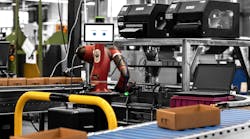With more than 100 manufacturing plants globally, the 178-year-old Stanley Black & Decker (SBD) has entrenched itself one of the world’s most recognizable and innovative brands.
A key component of the company’s staying power? The company has stayed on a clear journey of continuous improvement with dedication to innovation that includes regularly applying advanced technologies across the company’s operation, ultimately resulting in a culture dedicated to seeking “game changing solutions” that consistently yields an impressive number of new products and world firsts each year.As a result, SBD has become a perfect case study for digital transformation.
“The rationale for kickstarting this transformation journey was really about companywide innovation including our products, commitment to the customer experience of excellence, and our production process,” says Stanley Black & Decker’s CTO for Global Operations and Global Vice President of Industry 4.0 Sudhi Bangalore.
Supporting and enabling the transformation are what Bangalore refers to as the three gold goals – goals that serve as building blocks for the company’s transformation:
Deployment successes
Of course, having a solid strategy is great, but it has little meaning unless it yields successful deployments. SBD has been fortunate to realize numerous successes.
One of the company’s first major transformation projects focused on effectively utilizing collaborative robots (cobots). As part of its overall robotics and automation strategy, the company started exploring routes to eliminate dangerous, dirty and dull operations within its facilities. “Cobots and related systems can be a wonderful way to do it, so we started that initiative, created standards, worked with a few partners and created playbooks,” he says.
By all accounts, the cobot endeavor has been hugely successful. For instance, the cross-drill cobot deployed in the company’s Decatur, Georgia, plant increased productivity by 20% and improved labor efficiency, resulting in a 12-month payback. Today SBD has 100-120 cobot systems deployed.
“The cool thing is it has actually been deployed by operations. After we demonstrated how cobots can be a huge advantage to both the operations and the people, the operations team took over, and now it's a self-sustaining mechanism,” he says. “The real success is about getting people to embrace the value of thinking about things that they don't think of on a daily basis. The art of the possible and the art of the future. The people need to drive it, and make it part of their operating rhythm, which is exactly what happened in this particular example.”
Additionally, SBD has enjoyed the benefits of embracing a flexible automation platform. “We're working with a couple of partners, including a company called Bright Machines where they're now bringing huge level of agility to how we actually build our products using automation,” he says. “We can change SKUs using software, you don't have to worry about putting in a brand-new automation system. We can just change the cell configuration, and automatically the whole line changes configuration. It's a whole new level of value it's bringing to our build where we sell principle.”
Naturally, with each success come learning opportunities.
Case in point? Bangalore understands how important it is to gain traction early on with solutions that can really resonate with the workforce, so they start using it and keep driving value. However, sometimes it’s easy to go a little overboard in creating solutions with a focus on deployment.
“We realized early-on that we were not putting enough focus on creating standards, especially software standards, in terms of how we can actually have a large set of companies engaging on those standards as they build the solutions and apps we will need,” he says. “This is crucial, because in many instances, external partners are crucial. Along with a clear vision, standards are the only thing that keeps it all together.”
Also, when working with startups, it’s important to remember that while agility and flexibility make them great at delivering a tremendous amount of innovation, they often struggle to scale. “As such, transformation program leaders need to make sure that there's a scaling mechanism in place,” he says. “It's always a delicate balance between enjoying the power of innovation and passion that comes with startups, and then balancing it with risk management and mitigation.”
With SBD sitting at the forefront of the changes shaping the future of manufacturing, Bangalore has a clear passion for innovation including serving as one of the leaders driving collaboration with a NAM campaign called Creators Wanted, which focuses in part on how small and midsized manufacturers can best leverage digital technologies to transform their operations.
“We believe that we can be a force for greater good,” he says. “We believe focusing on transforming at scale can actually be a big benefit to the industry because we are willing to share.”
Start with people. A successful transformation has a diverse and talented team with specific qualities. “For instance, you always need a spokesperson for operations who is passionate and really understands how operations run to be the proxy for the people,” he says. “Of course, you need to make sure that person is open to and loves technology, so they will help you build the best solution set possible.”
Look past shiny objects. Rather than chasing after the next shiny object, think smart about what you can bypass. “For example, everyone talks about having visualization and insight with analytics,” he says. “But when you to have insights, you have to then convert those into something meaningful that somebody can actually use in a factory. When you can condense the process, you unlock tremendous value, because you don't need a data scientist to pass along the needed action. It is about democratizing technology.”
Beyond the business case. The biggest challenge with all these transformation programs is keeping the business case in perspective. “You can write business cases, very accurately, but you really need executive champions who have a level of passion and confidence with technology. You need to use common sense around where this whole journey has been,” says Bangalore. “It's fine mix of business case details and acumen, along with your own gut feeling about where the technology is in order to commit with scale and confidence.”
Prepare for adversity. It is equally important to know there will always be naysayers. “Make sure you have the right people on your team who are ready for those questions. You need to be able to be patient, communicate and bring those folks along by truly sharing what this technology set will do for operations, including the people,” he says. “It's change management and it's complicated. You need to think broad and creative in terms of how you show people the change. Unfortunately, for those who never embrace the change, companies need to be ready to say they cannot be part of the journey. You need to be ready for those discussions as well.”
With the right mix of strategy, technology selection and people, a transformation can play a valuable role in positioning an organization for sustainable success. At SBD, the ongoing transformation is unlocking tremendous value, projected to be in the 10s-100s of millions of dollars over time, explains Bangalore.
“We are at a terrific point where we have technology solutions, the people and an operating rhythm that has been honed-in – and we're not chasing after everything,” he says. “We have learned to avoid having a bunch of disparate technologies that result in a bunch of individual technology applications that fail to talk to one another. Instead, we are building a powerful, intelligent architecture with longevity built-in.”








